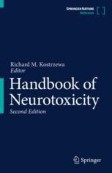Search
Search Results
-
The Gut Microbiome, Microbial-Produced Pro-inflammatory Neurotoxins, and Neurological Disorders
The gut microbiome is now recognized as a crucial determinant of human health and diseases, and it has been increasingly implicated in the...
-
Exploring Caenorhabditis elegans as Parkinson’s Disease Model: Neurotoxins and Genetic Implications
Parkinson’s disease (PD) is the second most common neurodegenerative disease in the world, the first being Alzheimer’s disease. Patients with PD have...

-
Toxicology and pharmacology of botulinum and tetanus neurotoxins: an update
Tetanus and botulinum neurotoxins cause the neuroparalytic syndromes of tetanus and botulism, respectively, by delivering inside different types of...

-
Molecular Mechanism and Effects of Clostridial Neurotoxins
The genus Clostridia, gram-positive anaerobic bacteria, produce two of the deadliest toxins known to mankind: tetanus and botulinum. Toxicity of...
-
Survey of the Spectrum of Classic Selective Neurotoxins
Selective neurotoxinsSelective neurotoxins are of value because of their ability to selectively destroy or disable a common group of nerves...
-
Survey of the Spectrum of Classic Selective Neurotoxins
Selective neurotoxinsSelective neurotoxins are of value because of their ability to selectively destroy or disable a common group of nerves...
-
Spider Neurotoxins as Modulators of NMDA Receptor Signaling
Molecules that selectively act on N-methyl-D-aspartate (NMDA) receptors may have a multidirectional effect by modulating the activity of NMDARs,...

-
An Alternative Explanation for Alzheimer’s Disease and Parkinson’s Disease Initiation from Specific Antibiotics, Gut Microbiota Dysbiosis and Neurotoxins
The late onset neuropathologies, including Alzheimer’s disease and Parkinson’s disease, have become increasingly prevalent. Their causation has been...

-
Future Prospects of Pain Treatment with Botulinum Neurotoxins
The treatment of pain with botulinum neurotoxins is now entering a new era due to the discovery of new peripheral and central pain receptors and the...
-
Survey of Selective Monoaminergic Neurotoxins Targeting Dopaminergic, Noradrenergic, and Serotoninergic Neurons
The concept of selective neurotoxicity was highlighted in the 1930s by the noted Physiologist Walter Canon who promoted the concept of “absence...
-
Survey of Selective Monoaminergic Neurotoxins Targeting Dopaminergic, Noradrenergic, and Serotoninergic Neurons
The concept of selective neurotoxicity was highlighted in the 1930s by the noted Physiologist Walter Canon who promoted the concept of “absence...
-
Light Chain Role in Action of Botulinum Toxins/Clostridial Neurotoxins
The clostridial neurotoxins (CNT), botulinum neurotoxins (BT) and tetanus neurotoxin (TT), are the most toxic protein toxins for humans. BT isolates...
-
Treatment of Dystonic Pain with Botulinum Neurotoxins
Focal dystonia is a common neurological disorder which is often painful. This chapter reviews clinical features of three common and painful focal...
-
Dopamine and L-Dopa as Selective Endogenous Neurotoxins
Selective neurotoxins have the ability to exert their neurotoxic effects in dopaminergic neurons. This could depend on their affinity to the dopamine...
-
Botulinum Neurotoxins and Chronic Low Back Pain
Chronic low back pain (cLBP) is the most common cause of medical disability. Treatment of cLBP is complicated due to its diverse etiologies and high...
-
Analgesic Effects of Botulinum Neurotoxins: Data from Animal Studies Volunteers
Recent discoveries of the new pain receptors and channels as well as pain modulators and transmitters have improved our knowledge of pain...
-
Dopamine and L-Dopa as Selective Endogenous Neurotoxins
Selective neurotoxins have the ability to exert their neurotoxic effects in dopaminergic neurons. This could depend on their affinity to the dopamine...
-

-
5,6- and 5,7-Dihydroxytryptamines as Serotoninergic Neurotoxins
Dihydroxytryptamines are able to selectively destroy central serotonin neurons when catecholaminergic neurons are protected. Compared to serotonin,...
-
Structure and Mechanism of Function of Botulinum Neurotoxins: How Does the Toxin Work
This chapter discusses the molecular structure of botulinum toxin and how the toxin gets into the nerve cells after being injected into the muscle or...
